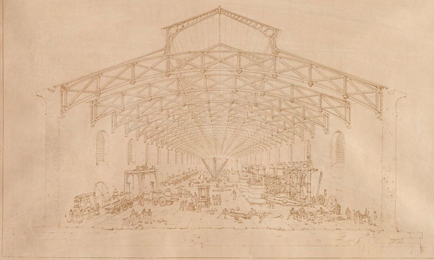Articles
Safe keeping: The IMechE holds many of Nasmyth's works of art
James Nasmyth was multi-talented and precocious – he made his first steam engine at the age of 17. He was born on 19 August 1808 in Edinburgh, and had a keen interest in engineering from an early age.
In his autobiography, he describes making spinning tops while at school that his peers would “pay any price” for. He also made flying kites and tissue-paper balloons and had quite the reputation for being very skilled in production.
He spent a lot of time in his father’s workshop and in the foundry owned by the father of his friend Jemmy Patterson. It was here that he became skilled in casting.
When he was 21, he went to London to work as Henry Maudslay’s assistant and then draughtsman, eventually branching out and setting up business on his own in Manchester aged only 23. He then went on to invent numerous machine tools with Nasmyth Gaskell and Co – including, most famously, the steam hammer.
His father, Alexander Nasmyth, was a well-known landscape painter and fostered his son’s love of art and drawing which he held throughout his life. James Nasmyth writes in his autobiography that “drawing was as familiar to me as language. Indeed, it was often my method of speaking... I need not say with how much pleasure I executed these drawings in my evening hours”.
In the archive at the institution we have many of his original drawings – from personal sketches such as “The Fairies” to original drafts for his steam hammer – which is shown crushing a bottle of red wine. He drew his personal sketches with lithographic ink.
He notes that he never had any published, but he did have some of them printed by a Mr Maclure. He would often send these copies to friends for them to enjoy. Earl Campderdown received a copy of “The Fairies” and commented that he would have “much pleasure in being reminded as I look at the drawings that the same hand and head that executed them invented the steam hammer, and many other gigantic pieces of machinery which will tend to immortalise the Anglo-Saxon race”.
Interestingly enough, Alexander Nasmyth had a lay interest in his son’s eventual profession – mechanical engineering. Some of James Nasmyth’s earliest memories are of observing visitors to his father’s workshop, and pulling on their coat tails to tell them “my papa’s a kevie fellae!”. It was here in his father’s workshop that he first began experimenting and designing.
When he retired from engineering, aged 48, Nasmyth developed a keen interest in astronomy. He writes in his autobiography: “I cannot find words to express the thoughts which the impressive grandeur of the stars” elicit. Both his father and Maudslay influenced this love of astronomy. Indeed, Nasmyth notes how he built a telescope with Maudslay but it was not completed because of his mentor’s decease.
In his retirement, however, Nasmyth desired to “possess a telescope of considerable power”.
The instrument he built – later to be known as the Nasmyth telescope – had a 10-inch diameter speculum which he said was so brilliant that it made his friend William Lassell’s “mouth water”. Nasmyth made drawings and plaster sculptures of the surfaces of the moon, and co-wrote a book on it: The Moon: Considered as a Planet, a World, and a Satellite. He even has a crater on the moon named after him.

Personal sketches: Drawing brought James Nasmyth much pleasure